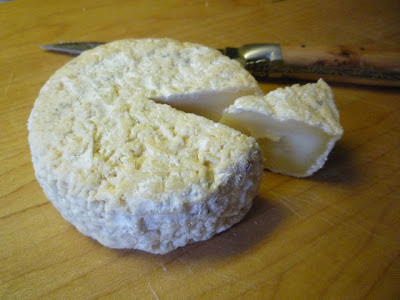Ossau-Iraty is a classic sheep milk cheese made in the French Pyrénées.
Ossau-Iraty has a natural rind with hues ranging from pale yellow, to golden-orange to light gray. The ivory colour pâte is an uncooked, pressed paste that is supple and creamy when young and becomes more firm and crumbly as the cheese ripens. Ossau-Iraty is creamy and buttery in the mouth with wonderful complex nutty flavours with hints of fruits and herbs.
The cheese's name Ossau-Iraty, reflects its dual origin: Ossau in the valley of Bearn, with its long history of Basco-Béarnaise breed of sheep, and Iraty the wooded hills of the French Pays Basque, home to the black and red-headed Manech ewes.
Ossau-Iraty received its Appelation d'Origine Controlee (A.O.C) nomination in 1980. AOC stipulations for making Ossau-Iraty cheese includes, the production of a specific sheep milk of the region, the manufacture and ripening of the cheese and of course the exclusivity to the specific geographical area.
During the affinage process of Ossau-Iraty, the cheese must be salted, it is washed in a brine, which enables the cheese to form a rind, then the cheese is placed in a cave d’affinage with regulated temperatures between 6 to 15°C and a high humidity level of 75%. During the ripening stage, the cheese rinds are then brushed with salt and some are brushed with a purée de 'Piments d'Espelette', a red chili pepper purée.
Another stipulation by AOC is the cheese must be aged at least 120 days before consumption for wheels weighing 4 to 7 kilos and 80 days for the smaller wheels of 2 to 3 kilos. Fromagerie Agour one of Ossau-Iraty producers age their wheels anywhere between 4 to 17 months.
Fromagerie Agour located in the Basque village of Hélette, France produced the winning Ossau-Iraty that was crowned the World Champion Cheese at the World Cheese Awards in 2006 and again in 2011, in Birmingham, England.
Pictured above is Ossau-Iraty aux Piments d'Espelette. Espelette is a variety of chili pepper that is cultivated in the French commune of Espelette, in the Atlantic-Pyrénées. The Espelette pepper was classified an AOC product in 2000.
Ossau-Iraty pairs well with many wines, especially a white Jurançon or Sauvignon Blanc or a French red Madiran or Merlot.
Sheep photos source: http://www.3srbreeding.eu/













